May 7, 2018
by Carole Zangari -
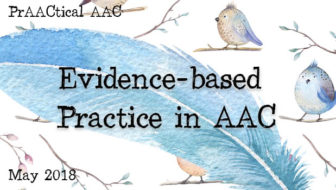
Dr. Jill Senner and Matthew Baud are staunch advocates for using research-based strategies and other evidence-based practices (EBP) in their AAC work. In today’s post. they share their thoughts on what EBP is, why it is important for AAC professionals, and how to incorporate it into our clinical and educational practices. :::::::::::::::::::::::::::::::::::::::::::::::::::::::::::::::::::::::::::::::::::::: Facts Matter: EBP in AAC Evidence-based practice (EBP) has been a buzz word in healthcare and education for almost two decades. However, “it has been well documented in many disciplines that major gaps exist between what is known as effective practices (i.e., theory and science) and what is actually done (i.e., policy and practice)” (Fixsen et al., 2005, p. 2). What is EBP, why is it important and how can we make sure we’re incorporating evidenced-based practices into our work with students and clients using AAC? Let’s take a look at answers to each of these questions below.... [Read More...]
Filed under: Featured Posts, PrAACtical Thinking
Tagged With: EBP, research
May 6, 2018
by Carole Zangari -
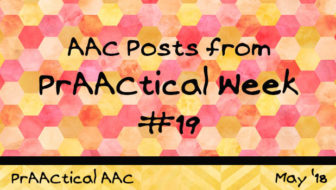
Hello, May – you sure are keeping us busy! I hope your week was a little saner than mine. In case you missed them, here are some of last week’s posts. Monday – On the Same Page: Helping Team Members Recognize and Respond to Unconventional Communication Signals Tuesday – AAC Link Up Wednesday – Video of the Week: iPad Apps for Learners with Complex Needs Thursday – AAC Assessment Corner with Vicki Clarke: Evaluating Skills for Use of Comprehensive AAC Dynamic Display SGDs ::::::::::::::::::::::::::::::::::::::::::::::::::::::::::::::::::::::::::::::::::::::::::::::::::::::::::: And if you have a bit more time, take a look at some of our previous posts. Saying ‘I love you’ on Mother’s Day AAC Immersion – Happy Mother’s Day! PrAACtically Reading with Karen Natoci: Are You My Mother? From ‘No AAC’ to ‘AAC All Day, Every Day!’ Autism and AAC: 5 Things I Wish I Had Known ::::::::::::::::::::::::::::::::::::::::::::::::::::::::::::::::::::::::::::::::::::::::::::::::::::::::::: Check out these resources for Better Hearing and Speech Month.... [Read More...]
Filed under: PrAACtical Thinking
Tagged With: summary post
May 3, 2018
by Carole Zangari -
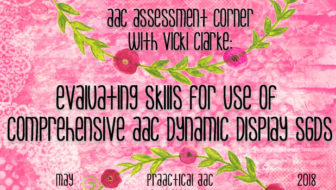
We’re always thrilled to share a guest post on AAC assessment practices from Vicki Clarke of Dynamic Therapy Associates. If you have questions about conducting AAC evaluations, read on. You can view her previous contributions to the AAC Assessment Corner here. :::::::::::::::::::::::::::::::::::::::::::::::::::::::::::::::::::::::::::::::::::: Evaluating Skills for Use of Comprehensive AAC Dynamic Display Systems Part I: Early Skills Over the past few years there has been an on-going discussion in the speech language pathology world about whether or not we needed to designate an official “specialty” recognition for augmentative and alternative communication practitioners. The argument goes something like this: It takes a lot of extra training, concerted effort in continuing education and daily practice in the assessment and implementation of augmentative communication to do it well. Therefore, we should have a “specialty area” in our national organization, ASHA, devoted to AAC. The counter-argument states that if our governing body says you need to... [Read More...]
Filed under: Featured Posts, PrAACtical Thinking
Tagged With: assessment, dynamic screen, SGDs, Vicki Clarke
April 30, 2018
by Carole Zangari -
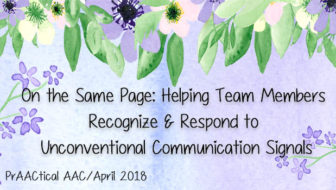
Joaquin grabs my wrists when he wants me to play. Ariella bangs her fists together when she wants more of something. Brayden paces anxiously when he needs to use the restroom. Do you work learners like these? Beginning communicators often use signals that are unconventional to express their emotional states, wants, needs, and ideas. That can work really well when the people in their lives recognize those signals and respond to the communicator’s intent. But when the signals are subtle or idiosyncratic, team members may miss them or misinterpret them. That’s unfortunate because when we accidentally ignore the beginning communicator’s signal or when we don’t respond in a way that reinforces their use, communication progress stalls out. One way to help get everyone on board in recognizing those unconventional or subtle forms of communication is to create learner-specific ‘dictionaries’ that help those who are not intimately familiar with the individual... [Read More...]
Filed under: Featured Posts, PrAACtical Thinking
Tagged With: beginning communicator, gesture dictionary
April 26, 2018
by Carole Zangari -
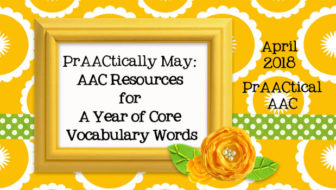
It is just about time to flip the calendar to a new page, and that means it’s time for a new set of core words to model, elicit, and practice. In this post, we have a number of resources for those who are ready to try their hand at implementation. Thanks to all who’ve reached out with questions, comments, and words of appreciation for the Year of Core Vocabulary series. Here are some helpful resources for those who are using the words in Set 1 ( Year of Core Words) or Set 2 (Another Year of Core Words). If you are contemplating this approach, feel free to jump in at any time. The best time to start (or re-start) is right now. Don’t worry about retracing steps, or not ‘doing it right.’ The best way to get better at core vocabulary instruction is just to keep at it. It takes... [Read More...]
Filed under: Featured Posts, PrAACtical Thinking
Tagged With: core vocabulary, implementation ideas
April 24, 2018
by Carole Zangari -
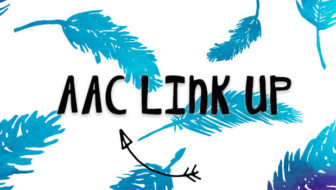
What’s new and interesting in your world of AAC? Each Tuesday, we invite you to share your own AAC-related goodness so that others may benefit from your efforts. It may be a recent post you’ve written, a slide deck from your AAC presentation, a handout, video, or meme that you’ve posted online, an AAC product you’ve created, an announcement for an AAC camp or conference, or any other prAACtical content you developed and want to share with the AAC community. To post your own link, scroll all the way down to the bottom of this post and complete the form. The AAC Link Up is moderated to keep us from being spammed, so it may take a little while for your link to show up. Note: If you receive this post in your email inbox, you are probably getting it before anyone has had a chance to add their links. Check back... [Read More...]
Filed under: Featured Posts, PrAACtical Thinking
Tagged With: AAC Link Up
April 23, 2018
by Carole Zangari -
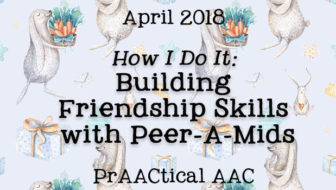
Many of our AAC learners need help building the knowledge and skills that are important when trying to connect with others and develop true friendships. In this post, SLP Katie Bernadkin shares one approach that she uses with her students. Katie is a New York City native now working in San Diego middle and elementary schools. She focuses on autism, AAC, and social cognition. In this post, she explains how uses Social Thinking’s Peer-A-Mid concept to support her students. :::::::::::::::::::::::::::::::::::::::::::::::::::::::::::::::::::::::: Building a Peer-a-mid Do you have any kids on your caseload that have a hard time recognizing when other kids are attempting to befriend them? Conversely, do you know the student who seems to always end up with a “friendly” peer, who is daring them to say something naughty? Recognizing these signs is such a valuable skill for our socially challenged kids to learn. I like to start with the... [Read More...]
Filed under: Featured Posts, PrAACtical Thinking
Tagged With: friendship, social cognition, social emotional development
April 19, 2018
by Carole Zangari -
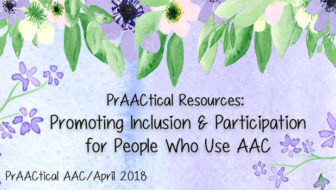
We’re so pleased to discover a new resource created by Talking Mats through a partnership with Scotland’s National Health Service Education. This guide, Promoting Inclusion and Participation A holistic approach to working with children and young people who use AAC, has lots of useful information, embedded video clips, discussion questions, and more. You can download the book here. (Note: It is a large file that takes awhile to download.) Kudos to the wonderful team at Talking Mats for their fine work on this project, and to NHS Education Scotland for making it available on their website!
Filed under: Featured Posts, PrAACtical Thinking
Tagged With: community, inclusion, schools
April 17, 2018
by Carole Zangari -
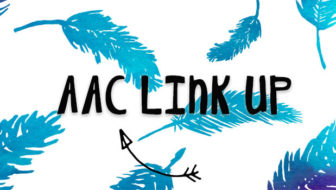
What’s new and interesting in your world of AAC? Each Tuesday, we invite you to share your own AAC-related goodness so that others may benefit from your efforts. It may be a recent post you’ve written, a slide deck from your AAC presentation, a handout, video, or meme that you’ve posted online, an AAC product you’ve created, an announcement for an AAC camp or conference, or any other prAACtical content you developed and want to share with the AAC community. To post your own link, scroll all the way down to the bottom of this post and complete the form. The AAC Link Up is moderated to keep us from being spammed, so it may take a little while for your link to show up. Note: If you receive this post in your email inbox, you are probably getting it before anyone has had a chance to add their links. Check back... [Read More...]
Filed under: Featured Posts, PrAACtical Thinking
Tagged With: AAC Link Up
April 16, 2018
by Carole Zangari -
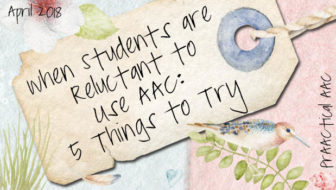
Work with students who are reluctant to use their AAC in front of others? Sometimes students become self-conscious and hesitate to use SGDs or other forms of AAC out of the fear that it will make them stick out. Of course, we do our best to encourage them but what else can we do? Here are a few things to try. Normalize AAC use: When lots of people use AAC, it reduces the student’s feeling that they stick out. Be relentless in your own modeling, and help others to build the habit of using AAC when they speak. Connect them with an AAC mentor: Role models can have a powerful influence on our perception of our world and ourselves. Connect students to others who use AAC successfully. If there aren’t older students or adults in your community, consider making online connections using social media. There are quite a few people... [Read More...]
Filed under: Featured Posts, PrAACtical Thinking
Tagged With: emotional competence, emotional support, peer supports, reluctant communicator, self-esteem









